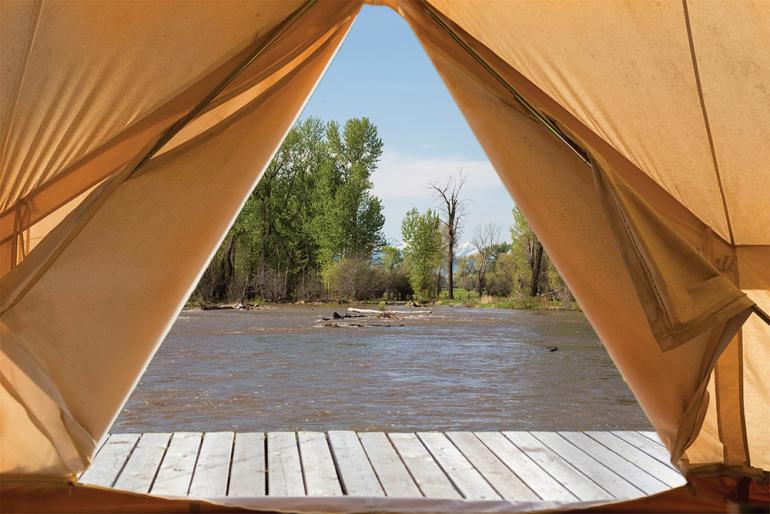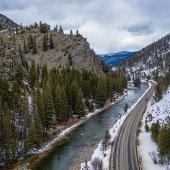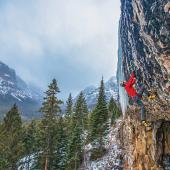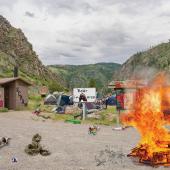Glamping Down
A proposal on the Gallatin leaves a sour taste.
Forty-four years ago, Gordan and I landed on the Gallatin River and never left, living in our own home in Gateway since 1981. We were captivated by the same allure that draws all of us to the valley: majestic mountain ranges, untouched wilderness, a diversity of wildlife, and the wild and precious Gallatin flowing down from Yellowstone Park. We’ve treasured the river’s beauty, tranquility, and ferocity for years, but burgeoning population growth has county and state agencies facing an ever-present challenge: protection.
On a quiet, sunny April afternoon in 2019, my husband and I, along with a fly fisherman we’d just met, were sitting in lawn chairs on the riverbank when a big, shiny all-terrain vehicle came rumbling from the south, driving right down the middle of the east channel. The vehicle in the river hailed from a recently purchased 16-acre property west of Gallatin Gateway. This was the beginning of a struggle to stop the destruction of this stretch of the Gallatin River and its island riparian habitat. Later we learned of the neighbor’s proposition to develop a 63-unit “Riverbend Glamping Retreat” on the island in the floodplain.
The extensive infrastructure outlined in the plans would potentially destroy the existing habitat. It would be unrecognizable. This floodway island in Gallatin Gateway consists of wetlands, spring creeks, open fields, and aspen and cottonwood tri-canopies, including some ancients that are homes for owls, eagles, and hawks. There is an abundance of wildlife including white-tailed deer, beaver, otter, bobcat, turkey, muskrat, great blue heron, and all kinds of waterfowl and other birds. Black bear, mountain lions, and moose are transient visitors.
How is the Gallatin protected? Agencies involved include the Gallatin County Conservation District, the Gallatin County Floodplain Administration, the Gallatin County Commission, the Montana DNRC, the Montana Department of Environmental Quality, and the Army Corps of Engineers, to name a few. With so many parties, it seems like a river should be protected no problem, right? Well, bureaucracy has its loopholes, and determined developers have perfected the science of navigating them.
Due to a lack of collaboration between agencies, federal and state oversight doesn’t wield the power it should. Nevertheless, the developer was still found in violation of a 310 permit—the permit necessary in order to work in or build near a stream—after excavating a large pond in late 2019.
When the glampground floodplain permit opened for public comment for a few short weeks in December 2020, over 1,000 petition signatures and 260 written comments were submitted opposing development. The developer’s application proposes to build a cement septic pump station, 20 feet from a spring and 50 feet from the river. We believe this would be prohibited in the Gallatin County Floodplain Regulations.
This proposed site is not some dry field or wooded forest well above the river and flood danger. It’s an area consisting of wetlands, riparian grass, and open woodland on an island. It floods frequently and the soil, sedges, and grassy cover are uniquely adapted to work with such natural events. Development of roads, parking lots, an underground sewer, water lines, fiber optics, and gas infrastructure to 63 units will demolish this natural riparian system just upstream from the property.
In January, surrounding landowners and neighbors in Gallatin Gateway formed a non-profit called Protect the Gallatin River (protectthegallatinriver.org) to provide updates and educational opportunities for folks advocating for the Gallatin River. Several major environmental and recreational groups have stepped forward with full-page ads in local publications, and petitions to review the applicable campground subdivision regulations.
In the next few months, the floodplain administrator will either grant or deny this application for “Riverbend Glamping Retreat,” and in doing so, set a precedent for the future. How do we want our Gallatin to be remembered? Do we want it protected, or destroyed by development? Will we preserve a place for wildlife, or let avarice eliminate even more habitat? What do we really want out of a river, a valley, and a way of life?













